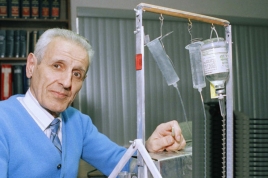Jack Kevorkian
Tuesday, August 4, 2020
Jack Kevorkian (May 26, 1928 – June 3, 2011) was an American pathologist and euthanasia proponent.
He publicly championed a terminal patient's right to die by physician-assisted suicide, embodied in his quote "Dying is not a crime". Kevorkian claimed to have assisted at least 130 patients, to that end. He was convicted of murder in 1999 and was often portrayed in the media with the name of "Dr. Death". There was support for his cause, and he helped set the platform for reform.
In 1998, Kevorkian was arrested and tried for his direct role in a case of voluntary euthanasia on a man named Thomas Youk who suffered from Lou Gehrig’s disease or ALS. He was convicted of second-degree murder and served 8 years of a 10-to-25-year prison sentence. He was released on parole on June 1, 2007, on condition he would not offer advice, participate, nor be present in the act of any type of suicide involving euthanasia to any other person; as well as neither promote nor talk about the procedure of assisted suicide.
Murad Jacob Kevorkian was born in Pontiac, Michigan, on May 26, 1928, to Armenian immigrants from present-day Turkey. His father, Levon (1887–1960), was born in the village of Passen, near Erzurum, and his mother, Satenig (1900-1968), was born in the village of Govdun, near Sivas. His father left Armenia in the Ottoman Empire and made his way to Pontiac in 1912, where he found work at an automobile foundry. Satenig fled the Armenian Genocide of 1915, finding refuge with relatives in Paris, and eventually reuniting with her brother in Pontiac. Levon and Satenig met through the Armenian community in their city, where they married and began their family. The couple had a daughter, Margaret, in 1926, followed by son Murad, and their third and last child, Flora.
As a child, his parents would often take him to church weekly. He started questioning the existence of a God, as he believed an all-knowing God would have prevented the Armenian genocide on his extended family. He stopped attending church by the time he was 12.
Kevorkian was a child prodigy. He was promoted to junior high in the sixth grade and taught himself multiple languages such as German, Russian, Greek, and Japanese. As such, he was often alienated by his peers. Kevorkian graduated from Pontiac Central High School with honors in 1945, at the age of 17. In 1952, he graduated from the University of Michigan Medical School in Ann Arbor.
Kevorkian completed residency training in anatomical and clinical pathology and briefly conducted research on blood transfusion.
Over a period of decades, Kevorkian developed several controversial ideas related to death. In a 1959 journal article, he wrote:
I propose that a prisoner condemned to death by due process of law be allowed to submit, by his own free choice, to medical experimentation under complete anaesthesia (at the time appointed for administering the penalty) as a form of execution in lieu of conventional methods prescribed by law.
Senior doctors at the University of Michigan, Kevorkian's employer, opposed his proposal and Kevorkian chose to leave the University rather than stop advocating his ideas. Ultimately, he gained little support for his plan. He returned to the idea of using death row inmates for medical purposes after the Supreme Court's 1976 decision in Gregg v. Georgia re-instituted the death penalty. He advocated harvesting the organs from inmates after the death penalty was carried out for transplant into sick patients, but failed to gain the cooperation of prison officials.
As a pathologist at Pontiac General Hospital, Kevorkian experimented with transfusing blood from the recently deceased into live patients. He drew blood from corpses recently brought into the hospital and transferred it successfully into the bodies of hospital staff members. Kevorkian thought that the U.S. military might be interested in using this technique to help wounded soldiers during a battle, but the Pentagon was not interested.
In the 1980s, Kevorkian wrote a series of articles for the German journal Medicine and Law that laid out his thinking on the ethics of euthanasia.
In 1987, Kevorkian started advertising in Detroit newspapers as a physician consultant for "death counseling". His first public assisted suicide, of Janet Adkins, a 54-year-old woman diagnosed in 1989 with Alzheimer's disease, took place in 1990. Charges of murder were dropped on December 13, 1990, as there were, at that time, no laws in Michigan regarding assisted suicide. In 1991, however, the State of Michigan revoked Kevorkian's medical license and made it clear that given his actions, he was no longer permitted to practice medicine or to work with patients.
According to his lawyer Geoffrey Fieger, Kevorkian assisted in the deaths of 130 terminally ill people between 1990 and 1998. In each of these cases, the individuals themselves allegedly took the final action which resulted in their own deaths. Kevorkian allegedly assisted only by attaching the individual to a euthanasia device that he had devised and constructed. The individual then pushed a button which released the drugs or chemicals that would end his or her own life. Two deaths were assisted by means of a device which delivered the euthanizing drugs intravenously. Kevorkian called the device a "Thanatron" ("Death machine", from the Greek thanatos meaning "death"). Other people were assisted by a device which employed a gas mask fed by a canister of carbon monoxide, which Kevorkian called the "Mercitron" ("Mercy machine").





